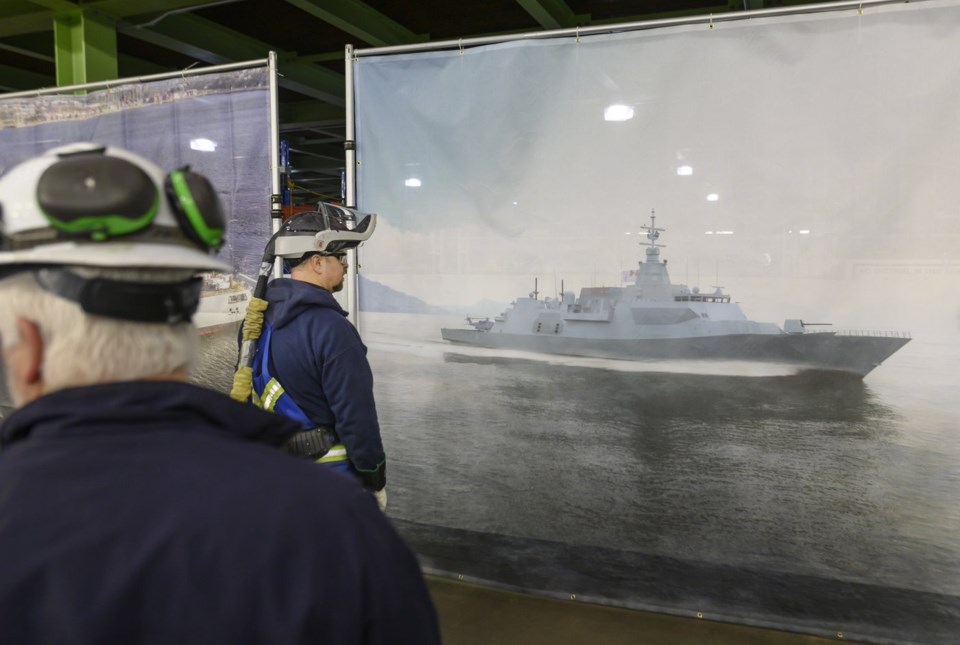HALIFAX — The Irving shipyard is testing methods to cut steel for saąúĽĘ´«Ă˝'s new destroyers, though the navy says it will be about a decade before the first vessel joins military operations.
Standing before hundreds of hard-hatted Halifax shipbuilders Friday, Defence Minister Bill Blair also announced that the 15 upcoming warships are officially designated as River class destroyers. They're named in recognition of Canadian warships that gained fame during the Second World War, and the waterways that lead to saąúĽĘ´«Ă˝'s coastlines.
However, the first of the ships — complete with missile systems and state-of-the-art radar — won't be capable of operating in the Royal Canadian Navy until 2035, with nine of the destroyers expected by 2040 and the full 15 by 2050, officials said in a briefing on Thursday evening.
Meanwhile, the formal construction contracts haven't been signed, and a final design is still in progress.
Blair nonetheless touted the early stages of construction as being "historic," while noting the urgency of building the destroyers.
"It's important we replace the Halifax frigates," he said. "They are reaching the end of their life cycle and it's becoming increasingly expensive to maintain."
Dave Perry, president of the Canadian Global Affairs Institute in Ottawa, said he's happy to see the project make some progress after years of delay.
"These ships will be a really significant increase in saąúĽĘ´«Ă˝'s naval capability," he said in an interview Thursday, adding that they will improve the country's ability to conduct any type of submarine warfare and to participate in NATO naval task forces.
But he also said the contracts need to be signed before the next federal election, to avoid further delays. "This government doesn't have a lot of time left and it's still got a bunch of unfinished business," he said.
Blair said Friday he expects the deal will be finalized while the Liberal government remains in office.
"Both the Royal Canadian Navy and the Irving shipyard need that contract in place .... I'm very confident we'll get it done before we have an election," said the Liberal cabinet minister.
Inflation and the navy's added requirements have been driving up the cost of the destroyers. While Blair and defence officials have continued to state the construction will cost $60 billion, the Parliamentary Budget Officer suggested in 2022 it could be as much as $80 billion.
Vice-Admiral Angus Topshee said Friday in Halifax that the Canadian ships, which are based on the BAE Type 26 design used in the United Kingdom and Australia, are heavier than their counterparts because of design changes.
The navy commander said the River class destroyers have a radar — considered the heart of the modern warship — located higher up in the vessel than in its Australian and British counterparts. That has required associated power, cooling and other supporting machinery, which add 900 tonnes in weight.
Topshee also said that while the Australian and United Kingdom Type 26 ships are primarily intended as anti-submarine escorts, the River class will be expected to defend against air attack and potentially to oversee command and control of other vessels.
On Friday, the Halifax shipyard started producing and testing what's referred to as "thin-steel" plates, which will eventually be used in the destroyers. The steel is less thick than the materials in the Arctic patrol vessels under construction at the yard. Topshee told reporters the actual production of steel that will be used in the first destroyer to be built — HMCS Fraser — will begin between April and October of 2025.
James Bezan, the Conservative Party's defence critic, said in an email that the project's timeline is a reminder that the Liberals have neglected the Armed Forces. The Liberal government, "failed to recruit enough sailors … our warships are rusting out and aging faster than expected, leaving our navy incapable," he wrote.
Richard Shimooka, a fellow at the Macdonald-Laurier Institute in Ottawa, said in an interview Thursday that while the navy is badly in need of new ships, its production timeline is not out of step with other nations building similar classes of vessel.
"We all wish the time frame were faster but it's probably going to take this long .... It's difficult to see other options to get something faster," he said.
This report by The Canadian Press was first published June 28, 2024.
Michael Tutton, The Canadian Press


